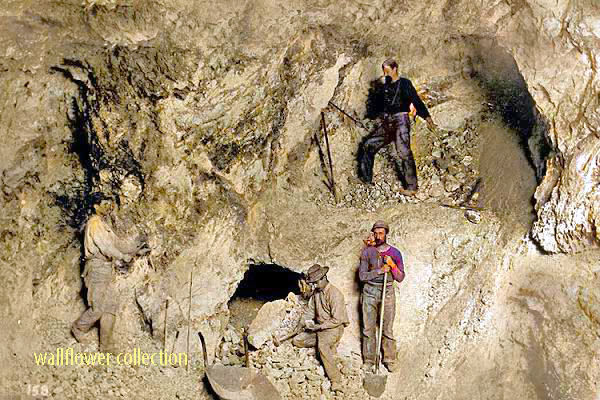Mining History in the Mojave Desert
An Overview of Mining in the California Desert
Larry Vredenburgh : Old Ores
Placer Gold
Placer gold, eroded from its host rock and deposited as nuggets or flakes in stream-bed gravel, provided the first non-native American mineral production in California. ...Scattered Survivors
Shortly after the scattered survivors of the “short cut” arrived in the gold country, a man named Turner ...Another Try
Fueled by the Lost Gunsight Mine story, prospectors began to scour the Death Valley region. ...Deserted and Hostile
As mining capital dried up in the mid-1860s, most of the mines within the California desert region were deserted. An outbreak of Indian hostilities at ...Silver as King
The significant output of silver during this time was influenced by events that were transpiring far away in Washington D.C. Silver was a relatively scarce commodity prior to ...Bodie, an Exception
Bodie, one of the premier gold mines in the region, was an exception to predominance of silver mining during the 1870s and 1880s. Rich gold was discovered in the ...The Southern Pacific
The Southern Pacific began construction at Mojave in February 1882 of a new line to Needles, on the Colorado River. The destination was reached April 19, 1883. At the same time ...Just a Year Earlier
Just a year earlier, in 1913, John Suckow, drilling for water on his homestead claim, at a depth of 40 feet discovered the largest borax deposit in the world, scarcely three miles north of the ...At about the same Time
At about the same time, the widespread copper-stained volcanic rocks of the Greenwater Range, east of Death Valley, convinced many that a literal mountain of copper ...Pittman Silver Act
In April, 1918 Congress passed the Pittman Silver Act. Under provisions of this law the United States purchased about $260 million dollars worth of silver at ...Bibliography
HIGHLIGHTS
Introduction:
Mining has played a significant role in shaping the history and economy of California. The vast and diverse landscape of the California Desert has been a rich source of minerals, attracting miners from all over the world. This document provides an overview of mining in the California Desert, highlighting its historical significance, major mining areas, and environmental impact.Historical Significance:
Mining in the California Desert dates back to the mid-19th century, during the California Gold Rush. Thousands of miners flocked to the region in search of gold, resulting in the rapid growth of towns like Bodie, Calico, and Randsburg. While gold was the primary mineral of interest, other valuable minerals such as silver, copper, and borax were also discovered and extracted.Major Mining Areas:
The California Desert encompasses several major mining districts with unique characteristics and mineral deposits. The Mojave Desert, located in the southern part of the state, is a prominent mining region. It is known for its abundant gold deposits, particularly in the Rand Mining District. The Panamint Range, located in the Death Valley region, was home to silver and lead mining operations.Furthermore, the Sonoran Desert, which extends into southeastern California, has been a significant area for copper mining. The Imperial Valley, known for its fertile agricultural lands, has also been a source of valuable minerals such as gypsum and salt.
Environmental Impact:
While mining has contributed to the economic development of the California Desert, it has also had a significant environmental impact. Mineral extraction often involves heavy machinery, resulting in land disturbance and habitat destruction. Additionally, releasing toxic substances, such as mercury and arsenic, during mining threatens the ecosystem and human health.Various regulations and best practices have been implemented to mitigate these environmental concerns over the years. The California Desert Conservation Area Plan, established by the Bureau of Land Management, aims to balance mining activities with environmental protection. It includes measures to minimize the impact on wildlife, conserve water resources, and reclaim disturbed lands.